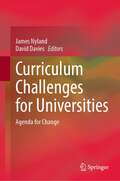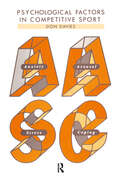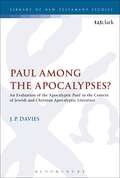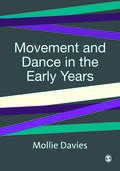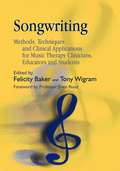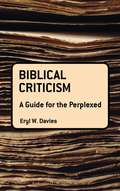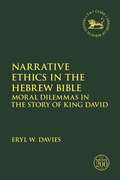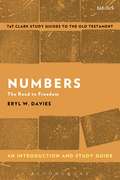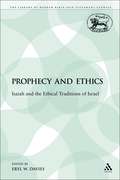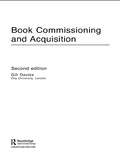- Table View
- List View
Teaching Science and Technology in the Early Years (3–7)
by Dan Davies Alan Howe Christopher Collier Rebecca Digby Sarah Earle Kendra McMahonTeaching Science and Technology in the Early Years (3-7) celebrates young children’s amazing capabilities as scientists, designers and technologists. Research-based yet practical and accessible, it demonstrates how scientific, designing and making activities are natural to young children, and have the potential for contributing to all aspects of their learning. By identifying the scientific and design-related concepts, skills and activities being developed, the book enables the reader to make more focused diagnostic observations of young children and plan for how they can help move them forward in their learning. This second edition has been thoroughly updated and features: Six new chapters providing practical advice and examples for enhancing scientific and technological learning through thematic approaches a new chapter focusing on the outdoor learning environment and how this can support science and technology new case studies of successful early years practice, alongside examples of practical planning for learning, and advice on documenting children’s learning stories, guidance on the role of talk, narrative, documentation and planning in relation to early years science and technology Based on the latest research and the first hand experience, this practical and accessible book is essential reading for early years and primary students on undergraduate and Masters level courses. ? ? ?
Teaching Science and Technology in the Early Years (3–7)
by Dan Davies Alan Howe Christopher Collier Rebecca Digby Sarah Earle Kendra McMahonTeaching Science and Technology in the Early Years (3-7) celebrates young children’s amazing capabilities as scientists, designers and technologists. Research-based yet practical and accessible, it demonstrates how scientific, designing and making activities are natural to young children, and have the potential for contributing to all aspects of their learning. By identifying the scientific and design-related concepts, skills and activities being developed, the book enables the reader to make more focused diagnostic observations of young children and plan for how they can help move them forward in their learning. This second edition has been thoroughly updated and features: Six new chapters providing practical advice and examples for enhancing scientific and technological learning through thematic approaches a new chapter focusing on the outdoor learning environment and how this can support science and technology new case studies of successful early years practice, alongside examples of practical planning for learning, and advice on documenting children’s learning stories, guidance on the role of talk, narrative, documentation and planning in relation to early years science and technology Based on the latest research and the first hand experience, this practical and accessible book is essential reading for early years and primary students on undergraduate and Masters level courses. ? ? ?
Teaching Science and Technology in the Early Years (3–7)
by Dan Davies Alan Howe Christopher Collier Rebecca Digby Sarah Earle Kendra McMahonTeaching Science and Technology in the Early Years (3–7) celebrates young children’s amazing capabilities as scientists, designers and technologists. Research-based yet practical and accessible, it demonstrates how scientific designing and making activities are natural to young children, and have the potential for contributing to all aspects of their learning. By identifying the scientific and technological concepts, skills and activities being developed, the book enables the reader to make more focused diagnostic observations of young children and plan for how they can help move them forward in their learning. This third edition has been thoroughly updated and features: fresh insights into young children’s learning from neuroscience and ‘new-materialist’ perspectives; a UK-wide perspective on Early Years curricula and how they support the inclusion of science and technology as an entitlement for young children; new case studies of successful, evidence-based Early Years practice, alongside new examples of practical planning for learning, and advice on documenting children’s learning stories; an updated chapter on assessing and documenting children’s learning, drawing upon findings from the Teacher Assessment in Primary Science (TAPS) project at Bath Spa University. Based on the latest research and first-hand experience, this practical and accessible book is essential reading for Early Years and Primary students on undergraduate, PGCE and Masters-level courses.
Teaching Science and Technology in the Early Years (3–7)
by Dan Davies Alan Howe Christopher Collier Rebecca Digby Sarah Earle Kendra McMahonTeaching Science and Technology in the Early Years (3–7) celebrates young children’s amazing capabilities as scientists, designers and technologists. Research-based yet practical and accessible, it demonstrates how scientific designing and making activities are natural to young children, and have the potential for contributing to all aspects of their learning. By identifying the scientific and technological concepts, skills and activities being developed, the book enables the reader to make more focused diagnostic observations of young children and plan for how they can help move them forward in their learning. This third edition has been thoroughly updated and features: fresh insights into young children’s learning from neuroscience and ‘new-materialist’ perspectives; a UK-wide perspective on Early Years curricula and how they support the inclusion of science and technology as an entitlement for young children; new case studies of successful, evidence-based Early Years practice, alongside new examples of practical planning for learning, and advice on documenting children’s learning stories; an updated chapter on assessing and documenting children’s learning, drawing upon findings from the Teacher Assessment in Primary Science (TAPS) project at Bath Spa University. Based on the latest research and first-hand experience, this practical and accessible book is essential reading for Early Years and Primary students on undergraduate, PGCE and Masters-level courses.
Teaching Science Creatively
by Dan Davies Deb McGregorHow can you unlock your own creativity to help children learn science creatively? How do you bring the world of ‘real science’ into the classroom? Where does science fit in a creative curriculum? Teaching Science Creatively explores how creative teaching can harness primary-aged children’s sense of wonder about the world around them. It offers innovative starting points to enhance your teaching and highlights curiosity, observation, exploration and enquiry as central components of children’s creative learning in science. Illustrated throughout with examples from the classroom and beyond, this book explores the core elements of creative practice supporting both teacher and children to develop their knowledge and skills. Key themes include: The importance of science in a creative primary curriculum The role of play in early scientific learning Developing children’s own interests and ideas into creative enquiry How theories of learning can help you understand children’s creative development Teaching science topics in innovative and creative ways - games, drama, role play, puppets, mini-safaris and welly walks! Using new technologies to enhance your science teaching in the classroom and outdoors Stimulating and accessible, with contemporary and cutting-edge practice at the forefront, Teaching Science Creatively introduces new ideas to support and motivate new and experienced primary teachers. It is an essential purchase for any professional who wishes to incorporate creative approaches to teaching science in their classroom.
Teaching Science Creatively
by Dan Davies Deb McGregorHow can you unlock your own creativity to help children learn science creatively? How do you bring the world of ‘real science’ into the classroom? Where does science fit in a creative curriculum? Teaching Science Creatively explores how creative teaching can harness primary-aged children’s sense of wonder about the world around them. It offers innovative starting points to enhance your teaching and highlights curiosity, observation, exploration and enquiry as central components of children’s creative learning in science. Illustrated throughout with examples from the classroom and beyond, this book explores the core elements of creative practice supporting both teacher and children to develop their knowledge and skills. Key themes include: The importance of science in a creative primary curriculum The role of play in early scientific learning Developing children’s own interests and ideas into creative enquiry How theories of learning can help you understand children’s creative development Teaching science topics in innovative and creative ways - games, drama, role play, puppets, mini-safaris and welly walks! Using new technologies to enhance your science teaching in the classroom and outdoors Stimulating and accessible, with contemporary and cutting-edge practice at the forefront, Teaching Science Creatively introduces new ideas to support and motivate new and experienced primary teachers. It is an essential purchase for any professional who wishes to incorporate creative approaches to teaching science in their classroom.
Teaching Science Creatively (Learning to Teach in the Primary School Series)
by Dan Davies Deb McGregorHow can you unlock your own creativity to help children learn science creatively? How do you bring the world of ‘real science’ into the classroom? Where does science fit in a creative curriculum? This second edition of Teaching Science Creatively has been fully updated to reflect new research, initiatives and developments in the field. It offers innovative starting points to enhance your teaching and highlights curiosity, observation, exploration and enquiry as central components of children’s creative learning in science. Illustrated throughout with examples from the classroom and beyond, the book explores how creative teaching can harness children’s sense of wonder about the world around them. With easily accessible chapters, it offers a comprehensive introduction to the core elements of creative science learning, supporting both teacher and child in developing scientific concepts and skills. The book explores key issues such as: • the links between scientific and creative processes• how to teach creatively, and for creativity• the role of play in early scientific learning• developing scientific understanding through drama (new)• using the outdoors in science• how theories of learning relate to children’s creative development• teaching science topics in innovative and creative ways – games, drama, role play, puppets, mini-safaris and welly walks! Stimulating and accessible, with contemporary and cutting-edge practice at the forefront, Teaching Science Creatively introduces fresh ideas to support and motivate both new and experienced primary teachers. It is an essential purchase for any professional who wishes to incorporate creative approaches to teaching science in their classroom.
Teaching Science Creatively (Learning to Teach in the Primary School Series)
by Dan Davies Deb McGregorHow can you unlock your own creativity to help children learn science creatively? How do you bring the world of ‘real science’ into the classroom? Where does science fit in a creative curriculum? This second edition of Teaching Science Creatively has been fully updated to reflect new research, initiatives and developments in the field. It offers innovative starting points to enhance your teaching and highlights curiosity, observation, exploration and enquiry as central components of children’s creative learning in science. Illustrated throughout with examples from the classroom and beyond, the book explores how creative teaching can harness children’s sense of wonder about the world around them. With easily accessible chapters, it offers a comprehensive introduction to the core elements of creative science learning, supporting both teacher and child in developing scientific concepts and skills. The book explores key issues such as: • the links between scientific and creative processes• how to teach creatively, and for creativity• the role of play in early scientific learning• developing scientific understanding through drama (new)• using the outdoors in science• how theories of learning relate to children’s creative development• teaching science topics in innovative and creative ways – games, drama, role play, puppets, mini-safaris and welly walks! Stimulating and accessible, with contemporary and cutting-edge practice at the forefront, Teaching Science Creatively introduces fresh ideas to support and motivate both new and experienced primary teachers. It is an essential purchase for any professional who wishes to incorporate creative approaches to teaching science in their classroom.
Curriculum Challenges for Universities: Agenda for Change
by David Davies James NylandThis book develops a progressive program of engagement with issues, problems and critical thinking which helps universities and students understand and engage with some of the key issues of our time. It focuses on curriculum concerns, and presents a sustained and critical analysis and dialogue about knowledge, culture and ways of seeing important issues. This book provides critical and analytical insights into the importance of the emergence of mass higher education into public awareness. It explores what is termed ‘contested knowledge’ as part of modern students’ experiences and expectations. By broadcasting some of the future prospects for a democratic university, especially in relation to its communities, it highlights the need to grasp the significance of global change and instability in teaching and learning, and how an adequate curriculum in higher education can be constructed to address the issues that arise.
Psychological Factors in Competitive Sport
by Don DaviesThis book explains the importance of psychological factors for achievement and performance in competitive sport. It deals with the development of ability, maximization of performance in competition, emotional health, social adjustement and general well being of the participants in sport. The two main aims are firstly to select and outline ways in which young people can learn to become highly skilled and well adjusted sportsmen and secondly to describe the techniques by which players, having become highly skilled, can perform consistently well under pressure or stress. This book is based on tried and tested methods in teaching and on extensive research findings in the field of sport psychology. There is a strong bias towards the practical and most chapters contain specific guidelines to be followed and detailed practices to be undertaken, making it ideal as a practical text for teachers, coaches or as an aid to self-improvement in the competitor.
Psychological Factors in Competitive Sport
by Don DaviesThis book explains the importance of psychological factors for achievement and performance in competitive sport. It deals with the development of ability, maximization of performance in competition, emotional health, social adjustement and general well being of the participants in sport. The two main aims are firstly to select and outline ways in which young people can learn to become highly skilled and well adjusted sportsmen and secondly to describe the techniques by which players, having become highly skilled, can perform consistently well under pressure or stress. This book is based on tried and tested methods in teaching and on extensive research findings in the field of sport psychology. There is a strong bias towards the practical and most chapters contain specific guidelines to be followed and detailed practices to be undertaken, making it ideal as a practical text for teachers, coaches or as an aid to self-improvement in the competitor.
Psychological Factors In Competitive Sport
by Don Davies Malcolm ArmstrongFirst published in 1989. This book explains the importance of psychological factors for achievement and performance in competitive sport. It deals with the development of ability, maximization of performance in competition, emotional health, social adjustement and general well being of the participants in sport. The two main aims are firstly to select and outline ways in which young people can learn to become highly skilled and well adjusted sportsmen and secondly to describe the techniques by which players, having become highly skilled, can perform consistently well under pressure or stress. This book is based on tried and tested methods in teaching and on extensive research findings in the field of sport psychology. There is a strong bias towards the practical and most chapters contain specific guidelines to be followed and detailed practices to be undertaken, making it ideal as a practical text for teachers, coaches or as an aid to self-improvement in the competitor.
Psychological Factors In Competitive Sport
by Don Davies Malcolm ArmstrongFirst published in 1989. This book explains the importance of psychological factors for achievement and performance in competitive sport. It deals with the development of ability, maximization of performance in competition, emotional health, social adjustement and general well being of the participants in sport. The two main aims are firstly to select and outline ways in which young people can learn to become highly skilled and well adjusted sportsmen and secondly to describe the techniques by which players, having become highly skilled, can perform consistently well under pressure or stress. This book is based on tried and tested methods in teaching and on extensive research findings in the field of sport psychology. There is a strong bias towards the practical and most chapters contain specific guidelines to be followed and detailed practices to be undertaken, making it ideal as a practical text for teachers, coaches or as an aid to self-improvement in the competitor.
Paul Among the Apocalypses?: An Evaluation of the ‘Apocalyptic Paul’ in the Context of Jewish and Christian Apocalyptic Literature (The Library of New Testament Studies)
by Dr J. P. DaviesA vibrant and growing field of discussion in contemporary New Testament studies is the question of 'apocalyptic' thought in Paul. What is often lacking in this discussion, however, is a close comparison of Paul's would-be apocalyptic theology with the Jewish and Christian apocalyptic literature of his time, and the worldview that literature expresses. This book addresses that challenge. Covering four key theological themes (epistemology, eschatology, cosmology and soteriology), J. P. Davies places Paul 'among the apocalypses' in order to evaluate recent attempts at outlining an 'apocalyptic' approach to his letters. While affirming much of what those approaches have argued, and agreeing that 'apocalyptic' is a crucial category for an understanding of the apostle, Davies also raises some important questions about the dichotomies which lie at the heart of the 'apocalyptic Paul' movement.
Movement and Dance in Early Childhood
by Dr Mollie Davies`This original and fascinating approach to children's movement development is highly recommended reading for tutors, practitioner and students alike' - Under Five `Movement and Dance in Early Childhood offers a clear and accessible entry into the world of movement and dance and the possibilities that exist for children, their families and the wider educational community' - Every Child `Eminently readable and accessible. Whether the reader is versed in movement understanding or a beginner, by the end of the book they should be a much better movement observer, teacher and handler' - Marion North, Principal and Chief Executive, Laban Centre for Movement and Dance In this unique and innovative book on movement and dance development from birth to eight years, the author draws on her depth of knowledge and practical experience in helping children to become skilled, creative and imaginative in a wide range of movement-oriented activities. The book seeks to help early childhood educators and parents in very practical ways and provides guidance based on a sound theoretical understanding. Originally published as Helping Children Learn Through a Movement Perspective, this book has been updated in the light of recent research. The author extends her investigation of how young children learn in and through movement. There is an expanded chapter on dance, which suggests strategies for working with young children and examines ways in which young children take on the roles of dance-makers, performers and appreciators. An additional chapter shows ways in which the expressive and artistic aspects of children's movement can be appropriately located and includes exemplars for dance at Key Stage 1 and the early phases of Key Stage 2.
Movement and Dance in Early Childhood (PDF)
by Dr Mollie Davies`This original and fascinating approach to children's movement development is highly recommended reading for tutors, practitioner and students alike' - Under Five `Movement and Dance in Early Childhood offers a clear and accessible entry into the world of movement and dance and the possibilities that exist for children, their families and the wider educational community' - Every Child `Eminently readable and accessible. Whether the reader is versed in movement understanding or a beginner, by the end of the book they should be a much better movement observer, teacher and handler' - Marion North, Principal and Chief Executive, Laban Centre for Movement and Dance In this unique and innovative book on movement and dance development from birth to eight years, the author draws on her depth of knowledge and practical experience in helping children to become skilled, creative and imaginative in a wide range of movement-oriented activities. The book seeks to help early childhood educators and parents in very practical ways and provides guidance based on a sound theoretical understanding. Originally published as Helping Children Learn Through a Movement Perspective, this book has been updated in the light of recent research. The author extends her investigation of how young children learn in and through movement. There is an expanded chapter on dance, which suggests strategies for working with young children and examines ways in which young children take on the roles of dance-makers, performers and appreciators. An additional chapter shows ways in which the expressive and artistic aspects of children's movement can be appropriately located and includes exemplars for dance at Key Stage 1 and the early phases of Key Stage 2.
Songwriting: Methods, Techniques and Clinical Applications for Music Therapy Clinicians, Educators and Students
by Emma Davies Tony Wigram Lucanne Magill Jeanette Kennelly Felicity Baker Jeanette Tamplin Amelia OldfieldThis comprehensive and groundbreaking book describes the effective use of songwriting in music therapy with a variety of client populations, from children with cancer and adolescents in secondary school to people with traumatic brain injury and mental health problems. The authors explain the specific considerations to bear in mind when working with particular client groups to achieve the best clinical outcomes. All the contributors are experienced music therapy clinicians and researchers. They provide many case examples from clinical practice to illustrate the therapeutic methods being used, together with notated examples of songs produced in therapy. Particular emphasis is placed on how lyrics and music are created, including the theoretical approaches underpinning this process. This practical book will prove indispensable to students, clinical therapists, music therapists, educators, teachers and musicians.
Biblical Criticism: A Guide for the Perplexed (Guides for the Perplexed #264)
by Eryl W. DaviesThis Guide for the Perplexed will demonstrate how modern biblical scholars have expressed dissatisfaction with a one-sided historical-critical approach to biblical texts and have argued that developments in secular literary theory should be applied in biblical studies. Whereas the historical-critical approach was concerned with the moment of a text's production (authorship, date, place of writing etc), the literary approach is concerned with the moment of the text's reception. Eryl W. Davies shows how and why approaches such as 'reader-response criticism', 'feminist criticism', 'ideological criticism', 'canonical criticism' and 'post-colonial criticism' are now becoming more popular in many quarters. The volume explains to the uninitiated in a readable and accessible form how strategies originally derived from secular literary criticism have been adopted by biblical scholars in order to understand the text of Scripture and to appreciate its relevance.
Biblical Criticism: A Guide for the Perplexed (Guides for the Perplexed #264)
by Eryl W. DaviesThis Guide for the Perplexed will demonstrate how modern biblical scholars have expressed dissatisfaction with a one-sided historical-critical approach to biblical texts and have argued that developments in secular literary theory should be applied in biblical studies. Whereas the historical-critical approach was concerned with the moment of a text's production (authorship, date, place of writing etc), the literary approach is concerned with the moment of the text's reception. Eryl W. Davies shows how and why approaches such as 'reader-response criticism', 'feminist criticism', 'ideological criticism', 'canonical criticism' and 'post-colonial criticism' are now becoming more popular in many quarters. The volume explains to the uninitiated in a readable and accessible form how strategies originally derived from secular literary criticism have been adopted by biblical scholars in order to understand the text of Scripture and to appreciate its relevance.
Narrative Ethics in the Hebrew Bible: Moral Dilemmas in the Story of King David (The Library of Hebrew Bible/Old Testament Studies)
by Eryl W. DaviesHow can the stories of the Hebrew Bible can be read for their ethical value? Eryl W. Davies uses the narratives of King David in order to explore this, basing his argument on Martha Nussbaum's notion that a sensitive and informed commentary can unpack the complexity of fictional accounts. Davies discusses David and Michal in 1 Sam. 19:11-17; David and Jonathan in 1 Sam. 20; David and Bathsheba in 2 Sam. 11; Nathan's parable in 2 Sam. 12; and the rape of Tamar in 2 Sam. 13. By examining these narratives, Davies shows that a fruitful and constructive dialogue is possible between biblical ethics and modern philosophy. He also emphasizes the ethical accountability of biblical scholars and their responsibility to evaluate the moral teaching that the biblical narratives have to offer.
Numbers: The Road to Freedom (T&T Clark’s Study Guides to the Old Testament)
by Eryl W. DaviesDavies outlines the composition and date of Numbers, and the various attempts that have been made to establish a coherent and meaningful structure in its arrangement. Davies also shows how the application of reader-response criticism, feminist criticism and postcolonial criticism have contributed to our understanding of selected passages in the book. Addressing theological issues, Davies considers three themes that occupy much of the content of Numbers, namely; land, purity and holiness, and rebellion. The concluding chapter considers the contentious issue of the historicity of the book of Numbers in the light of recent discussions concerning the historical value of the Old Testament. Davies shows how some of the issues Numbers raises – war, disease, survival, hunger, race relations – are among the perennial problems faced by nations across the centuries and across cultures. While individual passages within Numbers may reflect a questionable sense of morality, Davies demonstrates that the book, when viewed in its totality, encompasses a number of important theological themes which recur throughout the Old Testament: the interplay of forgiveness and judgment, and of sin and punishment, and the need to trust in the power of God rather than human might.
Numbers: The Road to Freedom (T&T Clark’s Study Guides to the Old Testament)
by Eryl W. DaviesDavies outlines the composition and date of Numbers, and the various attempts that have been made to establish a coherent and meaningful structure in its arrangement. Davies also shows how the application of reader-response criticism, feminist criticism and postcolonial criticism have contributed to our understanding of selected passages in the book. Addressing theological issues, Davies considers three themes that occupy much of the content of Numbers, namely; land, purity and holiness, and rebellion. The concluding chapter considers the contentious issue of the historicity of the book of Numbers in the light of recent discussions concerning the historical value of the Old Testament. Davies shows how some of the issues Numbers raises – war, disease, survival, hunger, race relations – are among the perennial problems faced by nations across the centuries and across cultures. While individual passages within Numbers may reflect a questionable sense of morality, Davies demonstrates that the book, when viewed in its totality, encompasses a number of important theological themes which recur throughout the Old Testament: the interplay of forgiveness and judgment, and of sin and punishment, and the need to trust in the power of God rather than human might.
Prophecy and Ethics: Isaiah and the Ethical Traditions of Israel (The Library of Hebrew Bible/Old Testament Studies)
by Eryl W. DaviesThe study attempts to examine the role of tradition in the teaching of Isaiah with a view to discerning the basis of the ethics presupposed by the prophet. The view that Isaiah's ethical pronouncements were dependent upon the legal, covenantal and wisdom traditions of Israel is discussed, and the possibility of a direct dependence on the oracles of his contemporary, Amos, is examined. Davies shows that the whole question of the influence of tradition on the thought of Isaiah is fraught with problems.
Book Commissioning and Acquisition
by Gill DaviesSince its first publication, this essential guide to book commissioning has established itself as the one and only 'must-read' for any successful editor, and the core training text used both within publishing houses and on publishing courses worldwide.In this new edition, Davies concentrates on the essential skills of commissioning, as well as other editorial challenges such as handling new lists following mergers and takeovers, and the demands of digital technology. New case-studies have been added which illustrate the commercial and practical problems that editors must address in today's complex and demanding marketplace.This book remains the one text that editors must have by their side throughout their careers.
Book Commissioning and Acquisition
by Gill DaviesSince its first publication, this essential guide to book commissioning has established itself as the one and only 'must-read' for any successful editor, and the core training text used both within publishing houses and on publishing courses worldwide.In this new edition, Davies concentrates on the essential skills of commissioning, as well as other editorial challenges such as handling new lists following mergers and takeovers, and the demands of digital technology. New case-studies have been added which illustrate the commercial and practical problems that editors must address in today's complex and demanding marketplace.This book remains the one text that editors must have by their side throughout their careers.




